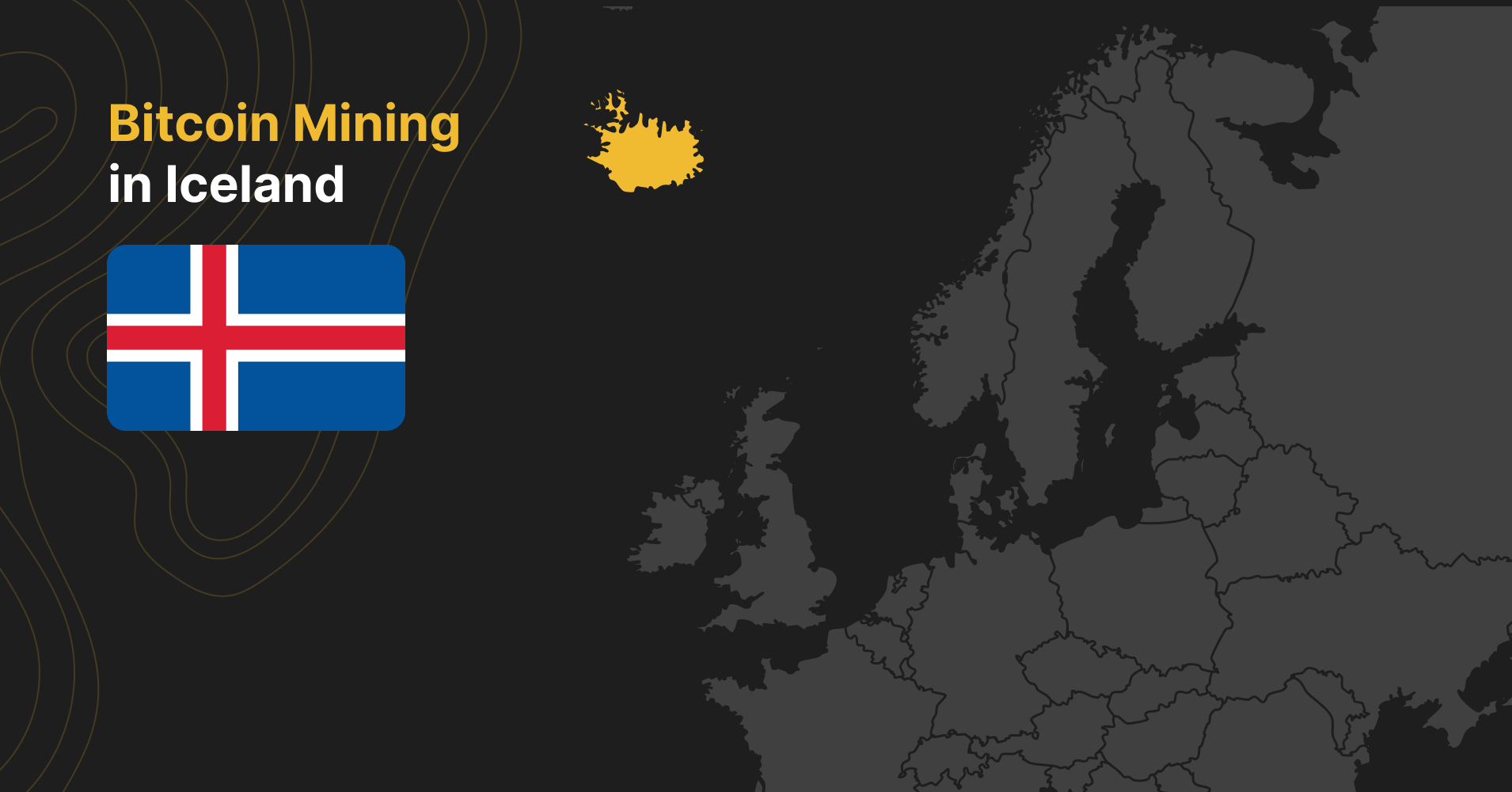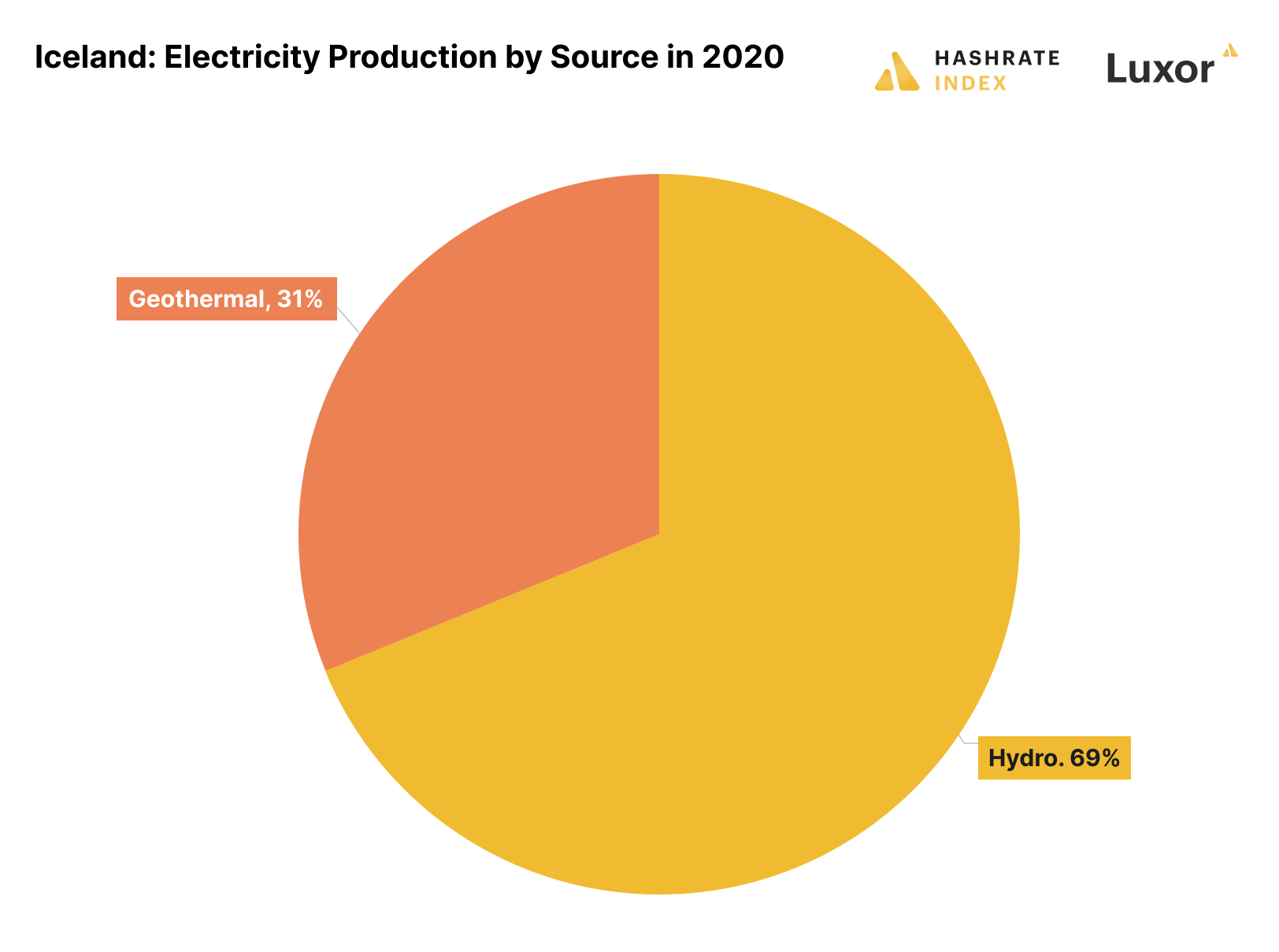
Bitcoin Mining Around the World: Iceland
Iceland is the biggest hashrate producer per capita globally.
Thanks to its massive amounts of stranded hydro and geothermal energy, Iceland has become one of Europe’s last bitcoin mining refuges. But what else defines the bitcoin mining industry on this volcanic island?
In this article, I explain why this tiny remote island has attracted one of Europe's largest bitcoin mining industries. At the end of the article, I give the country a bitcoin mining score based on several factors, including power prices, power price risk, regulatory environment, political risk, and operating conditions.
This article is the latest in our Bitcoin Mining Around the World series. Our previous articles cover Sweden, Norway, and Paraguay.
Iceland is the biggest hashrate producer per capita
Iceland has a long history of bitcoin mining. Thanks to its cheap electricity and entrepreneurial locals, it was one of the first countries outside China to see industrial-scale bitcoin mining emerge. The country is one of the biggest aluminum manufacturers globally, so people are used to the idea of exporting excess electricity through energy-intensive manufacturing. Given this background, it was easy for Icelanders to understand the concept of using bitcoin mining to monetize stranded energy.
We estimate the Icelandic bitcoin mining industry to consume around 120 MW. This power consumption should equal an Icelandic share of the global hashrate production of 1.3%, based on Hashrate Index’s Bitcoin Mining Energy Consumption Index, which currently sits at 9.3 GW. With a population of only 370 thousand, Iceland is the most bitcoin-mining-dense country on the planet.
Domestic companies involved in mining in Iceland include Greenblocks, Advania Data Centers, and Borealis Data Center. In addition, many international players currently operate or were previously there, like Genesis Mining, Bitfury, Hive Blockchain, and Startmining.
Powered by volcanoes and waterfalls
The Viking outlaws who once upon a time escaped Norway to settle in Iceland are likely not regretting their decision, as they now can feast on an almost limitless electricity supply. The mountainous geography, wet climate, and volcanic geology provide excellent conditions both for hydro and geothermal energy.

The industrious Icelanders have exploited their renewable energy resources by developing an impressive electricity system consisting of dozens of hydro and geothermal power plants and a transmission network circling around the island. Iceland is the most electricity-rich country in the world, generating almost twice the amount of electricity per capita as number two on the list, Norway.

What is Iceland doing with all this electricity? It has no interconnections with other countries but still exports enormous amounts of electricity. How? By manufacturing aluminum.
Iceland is the 10th largest aluminum manufacturer globally and the largest manufacturer per capita. Like bitcoin mining, aluminum manufacturing is enormously energy-intensive and can be used to export excess energy. Iceland uses 70% of its electricity to manufacture aluminum.

Iceland and Norway are the only countries in the world that are fully powered by renewable energy. Hydropower has historically been the backbone of Iceland’s electricity system, generating 69% of its electricity. However, since the 1990s, the Icelanders have mostly built out its geothermal capacity, which now generates 31% of its electricity.
Like Iceland was an early adopter of bitcoin mining, it’s also a pioneer in geothermal energy. El Salvador may have gotten the most attention in the Bitcoin community from its volcano mining project, but the Icelanders have quietly been volcano mining at a much larger scale for several years.
Iceland has among the cheapest electricity globally
With the highest electricity generation per capita globally, it is no surprise that electricity is cheap in Iceland. Still, due to the high demand of its energy-intensive industries, electricity has historically been slightly more expensive in Iceland than in other Nordic locations like northern Norway and northern Sweden.

During the previous five years, all-in electricity tariffs from the utility Landsvirkjun have stayed relatively stable between $51 and $71 per MWh. In 2022, the average all-in tariff sat at $63 per MWh, which provides decent margins for new-gen machines, given the current revenue per MWh of an Antminer S19j Pro at $116.
While miners can undoubtedly find cheaper electricity in other locations, one of the advantages of the Icelandic electricity system is its total isolation from the rest of the world, protecting it against global electricity price inflation. There are no interconnections between Iceland and continental Europe, and the country is not exposed to fuel prices since all of its electricity comes from renewable sources.
The all-in electricity tariffs shown in the chart above are set by the country’s national utility, Landsvirkjun. It is the nation’s largest electricity producer and is wholly owned by the Icelandic State. The company also owns most of the national grid.
Landsvirkjun and two privately-owned electricity producers sell electricity directly to power-intensive industries, like aluminum smelters and bitcoin miners, through long-term, fixed-price contracts. Large users of more than 10 MW can connect directly to the transmission system or make direct PPAs with generators and can thereby secure substantially cheaper electricity than shown in the chart above.
Electricity is getting scarcer in Iceland
Iceland’s electricity supply might have seemed endless a few years ago, but it has gradually become scarcer over the past few years. Since 2010 or so, the country has seen a tremendous increase in its electricity demand simultaneously as there has been little development of new power plants.
Due to the scarce electricity, Icelandic miners report that it is nearly impossible to get electricity allocation for new data centers. The only way to fix this situation is to increase the electricity supply, meaning building new power plants. Unfortunately, it looks like electricity will keep being scarce, as there are limited plans for such build outs.
Even though electricity is scarce, it is still cheap, and it will likely not get much more expensive, as hydro and geothermal have very low marginal costs of production. Icelandic miners also have a second line of defense against rising power prices in the form of long-term fixed-price electricity contracts.
The scarce electricity means that the bitcoin mining industry has limited growth potential in Iceland and will likely stay at around 120 MW for the foreseeable future. Still, if other energy-intensive consumers were to withdraw from Iceland, miners would be ready to tap into the extra available electricity.
The climate conditions couldn't be better for bitcoin mining
There are few countries where operating a mining farm is easier than in Iceland. This Arctic country's stable cold climate provides natural cooling to heat-producing mining operations. The average monthly temperatures in Iceland’s capital Reykjavik range from 1C (+34F) to +12C (+53F) between the coldest and warmest months. The climate barely gets any better for bitcoin mining.
The benign climate means maintaining and running a mining operation is more straightforward than in hotter bitcoin mining hubs like West Texas. Miners can easily run air-cooled operations and don’t need to worry about building additional cooling infrastructure. In addition, machines could last longer. The low failure rate due to the cold climate also means lower maintenance requirements, which could reduce operating costs.
Since Iceland has an almost endless water supply, miners can also use hydro setups to cool their machines.
Iceland is one of the most politically stable countries in the world
During the past few years, miners in many locations have encountered political or regulatory opposition in the form of rising electricity taxes, moratoriums, or even mining bans. Thus, bitcoin miners all over the world are becoming increasingly aware of the importance of operating in a politically stable jurisdiction.
Iceland is widely regarded as one of the safest and most politically stable countries globally. Miners have operated there for nearly ten years without any significant issues with the authorities, potentially making it the most stable bitcoin mining jurisdiction globally.
I would even argue that Iceland is a considerably more politically benign country for miners than other northern European bitcoin mining hubs like Norway and Sweden. Both these countries recently increased electricity taxes for data centers in attempts to curb the bitcoin mining industry as they want to reserve electricity for what the government believes are more desirable industries. According to the Icelandic miners I have talked with, there are no such ongoing discussions in the Icelandic government.
In addition, the data center industry, and bitcoin mining specifically, is a large industry in Iceland and has become a critical customer for the electricity sector. Therefore, any pushback from the government against the industry would be met with a massive lobbying effort.
Now, what about taxes? Iceland is no tax heaven, with a corporate tax level of 20% and a VAT rate of 24%. The VAT also affects imported products, including ASICs. Still, Icelandic miners can avoid the import VAT by registering their companies in the Icelandic VAT registry.
Conclusion
Thanks to its cheap renewable energy, cold climate, and political stability, Iceland has attracted a significant mining sector generating well above 1% of Bitcoin’s hashrate. Due to the nation’s small population, it is likely the largest hashrate generator per capita, just as it is the largest electricity producer per capita and the largest aluminum manufacturer per capita.
Stranded hydro and geothermal energy have spared Iceland from the energy price inflation that has ravaged Europe since late 2021, making this tiny island one of Europe's last bitcoin mining refuges.
Iceland is one of the world’s most politically stable countries, and the country’s bitcoin miners have operated peacefully without any issues for nearly ten years. Unlike its Nordic neighbors, the country will likely stay welcoming to miners and other data centers, as the data center industry is one of the country’s breadwinners along with other energy-intensive industries like aluminum manufacturing.
The biggest obstacle for Icelandic miners is getting access to new electricity. The country has seen little buildout of power plants in recent years, and electricity is getting scarce as a result. With the waterfalls and volcanoes running at maximum capacity, it is unlikely that the bitcoin mining industry will see significant growth in the coming years.
The two main bitcoin mining selling points of Iceland are the unbeatable political stability and the 100% renewable energy, making the country one of the premium locations for miners.
Are you scaling a Bitcoin mining operation and in need of mining software, services, or hardware? We can help. You can reach us here.

A big thanks to those who helped me with insights for this article. A special thanks to Daniel Jonsson (Greenblocks).
If you have any questions about mining in Iceland, or in any other countries, please DM me on Twitter @jmellerud
Hashrate Index Newsletter
Join the newsletter to receive the latest updates in your inbox.







